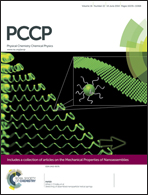Electronic and magnetic properties of armchair graphene nanoribbons with 558 grain boundary
Abstract
Grain boundaries (GBs) that inevitably appear in CVD-grown graphene affect the electronic properties of graphene-based nanomaterials. In this paper, we introduce 558 GB (composed of a pair of pentagons and one octagon alternately) into armchair graphene nanoribbons (AGNRs) and divide them into three groups in light of the end configurations of 558 GB at the ribbon edges. By using first-principles calculations, the variations of electronic and magnetic properties with two adjustable parameters W (ribbon widths) and NZ (the distances between 558 GBs) are systematically investigated for each group. The results show that different electronic and magnetic behaviors versus W and NZ are presented for varying end configurations of 558 GB, including nonmagnetic metals, ferromagnetic metals and nonmagnetic semiconductors. By introducing 558 GB into AGNRs, the impurity states that are completely contributed by 558 GB appear around the Fermi level. Furthermore, a ferromagnetic ordering on the two zigzag chains of 558 GB occurs for the ferromagnetic metals due to the spin splitting energy bands near the Fermi level. These unique electronic and magnetic properties of AGNRs with 558 GB would find their potential applications in electronic and spintronic devices.


 Please wait while we load your content...
Please wait while we load your content...